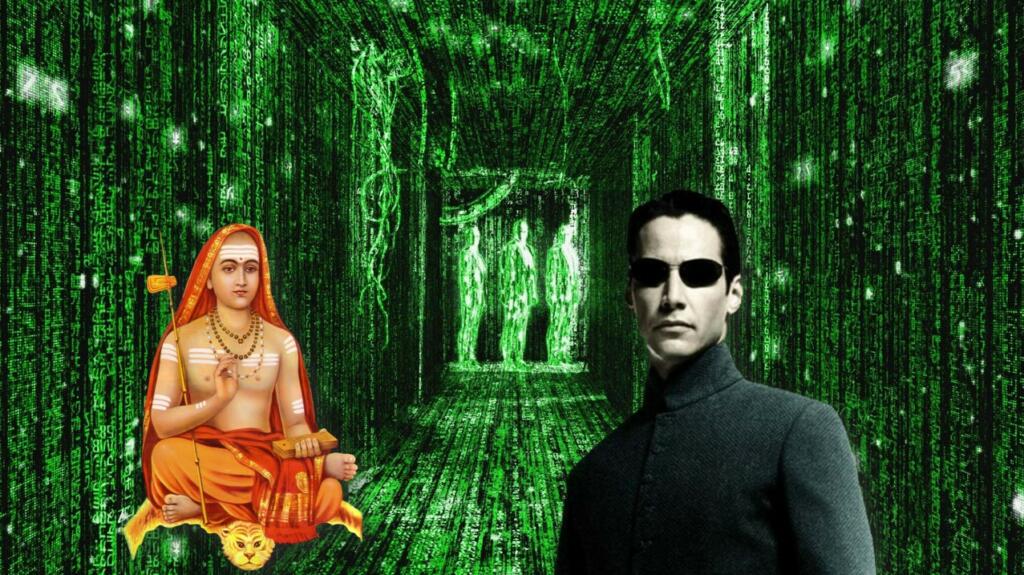Have you watched the Matrix trilogy? The most recent Matrix film came in the form of a fourth part, called ‘The Matrix: Resurrections’. The Matrix series is a sci-fi thriller that has fascinated people around the world, and its first part was among the only films to have talked about a dystopic future where artificial intelligence controlled the world, and humans were mere fodder for such technologies to run the world. Humans were harvested in pods, and they were shown an illusion using a programme called ‘The Matrix’. This programme made the harvested humans believe they were leading normal lives.
The humans felt they were living, leading normal lives – going to school, working, marrying, and having kids. It all felt so real. But it was all an illusion. The Matrix built a magnificent dream for all the human subjects who had been held unconsciously within the pods.
The essence of the Matrix is that the world is an illusion, a dream. It’s a yogic movie. What is holding back all humans is maya. It has blinded them, and they think that a fictitious world created by maya is real, when in fact, they are all being tricked. The film also makes it a point to emphasize how, if we can cut through the illusions and connect with something larger, we can do all sorts of things – even supernatural.
The Matrix and Advaita Vedanta
Do you know what other philosophy calls the world an illusion and a dream? The ancient Hindu philosophy of Advaita Vedanta. People who believe in Advaita believe that their soul is not different from Brahman. The most famous Hindu philosopher who taught Advaita Vedanta was Adi Shankaracharya, who travelled the length and breadth of India more than a thousand years ago.
Vedanta is the philosophy of the Vedas. Its basic teaching is that our real nature is divine. Religion, therefore, is not a path to attain God, but a way of spiritual awakening and self-realisation.
Now here are some quotes from the Matrix:
What if you were to wake up from a dream which was so
real that you found it difficult to differentiate
between the dream world, and the real world? – Morpheous to Neo
Your appearance now is what we call residual self-image.
It is the mental projection…of your digital self. – Morpheous to Neo
The Matrix is everywhere. It’s all around us, even in this
very room. You can see it when you look out your window or
when you turn on your television. You can feel it when you
go to work, when you pay your taxes.
The Matrix is the world that has been pulled over your eyes,
to blind you from the truth. – Morpheous to Neo
Don’t these dialogues sound very familiar to India? It’s almost like a Hindu wrote these lines. Well, many of them are inspired by the Upanishads.
In the films, it is possible to reincarnate, it is possible to awaken from the Matrix’s illusion and realise the truth and it is possible to defy the so-called laws of the system, or nature.
Morpheous acts as a Guru. He previously guided Trinity to realise the truth and then does the same with Neo. At one point in the first film, Neo asks Trinity, “What is the Matrix?” To this, Trinity replies, “Twelve years ago I met [Morpheus], a great man, who said that no one could be told the answer to that question. That they had to see it, to believe it.”
One cannot ‘find’ God, or Parmatma, or the ultimate reality. One can only realise it. The truth can only be experienced. When one realises, he or she attains Moksha.
Upon being told about the Matrix, Neo asks Morpheus, “This isn’t real?” Morpheus replies saying, “What is real? How do you define real? If you’re talking about your senses, what you feel, taste, smell, or see, then all you’re talking about are electrical signals interpreted by your brain.”
Matrix not about VFX and Martial Arts Alone
The Matrix film series has been portrayed as one which makes stellar use of special effects and martial arts alone. The discussion surrounding the film’s explicit Vedantic connotations has always been murmured, at best. However, the links between the film and ancient India’s Advaita Vedanta philosophy are just too pronounced to be ignored.
Read more: Caribbean Islands – A place of Sun, Sand and Sanātana
In the film, the goal was for humans to wake up. In the Vedantic tradition, the goal for humans is to wake up too. To wake up from their illusionistic slumber and realise the truth. To break the bondage of maya and realise the ultimate reality to attain Moksha.
